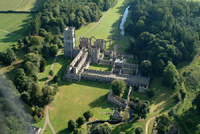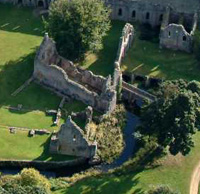 |
 |
 |
 |
 |
 |
 |
|
Fountains Abbey: History
Fountains Abbey: Buildings
|
Introduction
The place was called Fountains, where, at that Fountains Abbey was the second Cistercian outpost founded in the North of England. The first community overcame rather difficult beginnings to establish what was to become the largest and richest Cistercian abbey in the country. Fountains spawned an extensive family that extended as far as Norway, and the abbey played a prominent role in the export of wool. Throughout the Middle Ages, Fountains had its fair share of crises and triumphs, and became embroiled in political and ecclesiastical affairs. On several occasions the community stood at the very forefront of international events: in the mid-twelfth century, the abbey spearheaded opposition to the controversial appointment of William FitzHerbert as archbishop of York and led a delegation to the papacy; in the fifteenth century, ructions over the appointment of Roger Frank to the abbacy of Fountains caused the intervention of the pope, parliament and even the Council of Constance [1414-1418]. Fountains Abbey is of continuing importance today. It is a World Heritage site and the ruins are amongst the most significant monastic remains in Europe. These include the oldest surviving Cistercian water-mill, a splendid twelfth-century western range (once occupied by the lay-brothers), and a magnificent tower erected by Abbot Marmaduke Huby in the sixteenth century. Fountains has also given rise to exciting archaeological discoveries, with the identification of the first timber buildings, begun in 1134, and the layout of the guest complex - geophysical survey reveals a clear outline of the guesthall that once stood alongside the two remaining guesthouses, but is now invisible to the eye. Fountains is currently the focus of an extensive archaeological and architectural research project which, when complete, will make it one of the most clearly understood and well documented medieval abbeys. |

